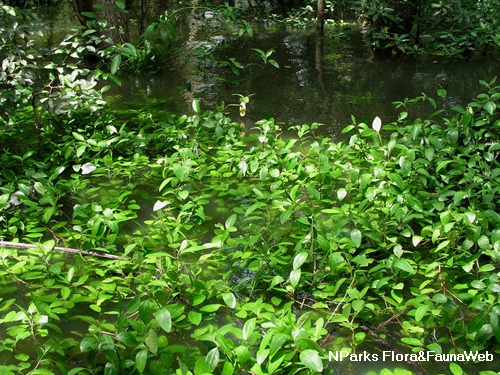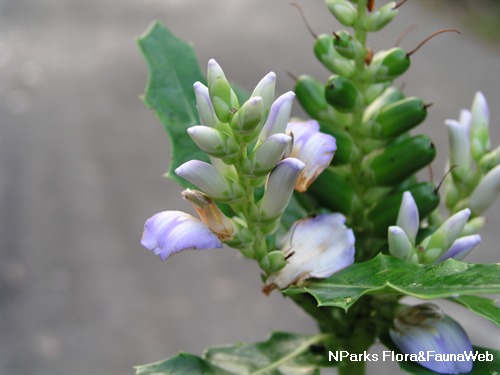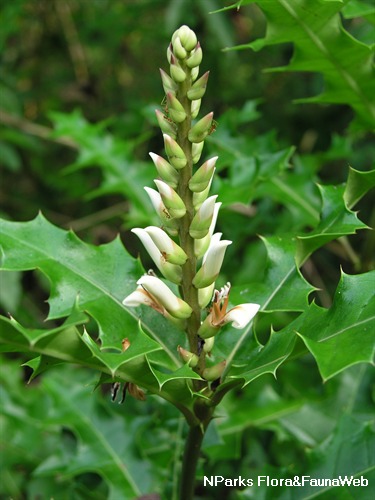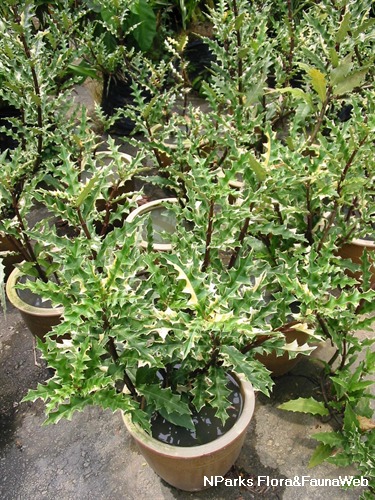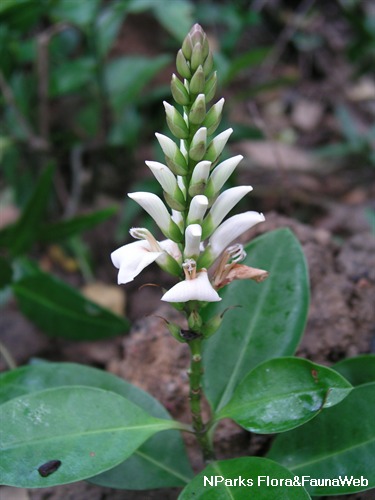
Name
Classifications and Characteristics
| Plant Division | Angiosperms (Flowering Seed Plants) |
|---|---|
| Plant Growth Form | Shrub |
| Lifespan (in Singapore) | Perennial |
| Mode of Nutrition | Autotrophic |
Biogeography
| Native Distribution | Southeast Asia including Singapore, Eastern India, Sri Lanka and Papua New Guinea |
|---|---|
| Native Habitat | Shoreline (Mangrove Forest) |
| Preferred Climate Zone | Tropical, Sub-Tropical / Monsoonal |
| Local Conservation Status | Native to Singapore (Endangered (EN)) |
Description and Ethnobotany
| Growth Form | Semi-erect to climbing plant, has thin, dark-green, smooth stems, 4 - 8 m in height. |
|---|---|
| Roots | Tap root system and sometimes the base of the stem is supported by slender stilt-roots arising from basal nodes. |
| Foliage | Leaf blades are smooth, entire or slightly lobed, usually without spines, fleshy to leathery, oblong-lanceolate, measuring 2.5 - 5 by 7 - 9 cm and have a blunt tip. Simple, opposite leaves with a leaf stalk about 1.0 cm long, slightly flattened and green. |
| Flowers | Flowers occur in nearly arranged long spike, 10 - 12 cm in length, located at the ends of branches. Petals are white and turn brown when older. Flowers measure 1.9 - 2.5 cm in length, 4 sepals of mixed sized, green, smooth, leathery, curved and pointed; petals number 5, fused to form a single plate, and the base is fused, forming a hollow, short tube, while the point flattened to form 5 short 2-lipped lobes. |
| Fruit | Rarely formed, consists of a capsule about 2.5 cm long, ellipsoid and flattened. |
| Habitat | Found in back mangrove forest and waterlogged areas. |
| Etymology | Acanthus is derived from the Greek word akanthos, and akanthos is derived from ake which means "point or thorn", and anthos which means "flower". |
| Ethnobotanical Uses | Medicinal: In Malay culture, powdered seeds are taken with water as a blood cleansing medicine against ulcers. |
Landscaping Features
| Desirable Plant Features | Ornamental Flowers, Ornamental Foliage |
|---|---|
| Landscape Uses | Parks & Gardens, Coastal, Beachfront / Shoreline, Hedge / Screening, Riverine, Suitable for Hanging Baskets |
Plant Care and Propagation
| Light Preference | Full Sun, Semi-Shade |
|---|---|
| Water Preference | Lots of Water |
| Plant Growth Rate | Fast |
| Rootzone Tolerance | Moist Soils, Saline Soils / Salt Spray, Fertile Loamy Soils, Easy to Grow |
| Maintenance Requirements | Low |
| Propagation Method | Stem Cutting |
Foliar
| Foliage Retention | Evergreen |
|---|---|
| Mature Foliage Colour(s) | Green |
| Foliar Type | Simple / Unifoliate |
| Foliar Arrangement Along Stem | Opposite |
| Foliar Attachment to Stem | Petiolate |
Non - Foliar and Storage
| Stem Type & Modification | Herbaceous |
|---|
Floral (Angiosperm)
| Flower & Plant Sexuality | Bisexual Flowers |
| Flower Colour(s) | White |
|---|---|
| Flower Grouping | Cluster / Inflorescence |
| Flower Location | Terminal |
References
| References | Yong J, Tan PY, Nor Hafiz Hassan, Tan SN. 2010. A Selection of Plants for Greening of Waterways and Waterbodies in the Tropics. Singapore: Chung Printing . 480 pp. |
|---|
Image Repository
Others
| Master ID | 32121 |
|---|---|
| Species ID | 6527 |
| Flora Disclaimer | The information in this website has been compiled from reliable sources, such as reference works on medicinal plants. It is not a substitute for medical advice or treatment and NParks does not purport to provide any medical advice. Readers should always consult his/her physician before using or consuming a plant for medicinal purposes. |


